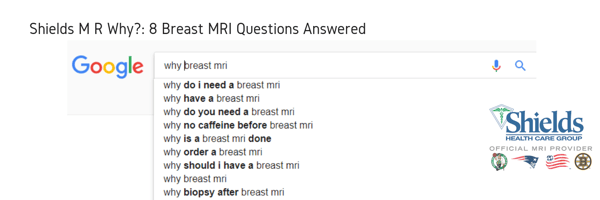
October is Breast Cancer Awareness Month -- an annual campaign to increase awareness of a disease that will affect 1 in 8 U.S. women over the course of their lifetimes. Awareness can lead to increased support for research, diagnosis and treatment for this disease. Besides skin cancer, breast cancer is the most commonly diagnosed cancer among American women. Experts agree that early detection is critical when dealing with this disease. So how is breast cancer diagnosed? And why might your doctor recommend a breast MRI? These and other patient questions are answered below.
How is breast cancer diagnosed?
Tests and procedures used to diagnose breast cancer include:
- Breast exam: Your doctor will check both of your breasts and lymph nodes in your armpit, feeling for any lumps or other abnormalities.
- Mammogram:A mammogram is an X-ray of the breast. Mammograms are commonly used to screen for breast cancer. If an abnormality is detected on a screening mammogram, your doctor may recommend a diagnostic mammogram to further evaluate that abnormality.
- Breast ultrasound: Ultrasound uses sound waves to produce images of structures deep within the body. Ultrasound may be used to determine whether a new breast lump is a solid mass or a fluid-filled cyst.
- Breast magnetic resonance imaging (MRI):An MRI machine uses a magnet and radio waves to create pictures of the interior of your breast. Before a breast MRI, you receive an injection of dye. Unlike other types of imaging tests, an MRI doesn't use radiation to create the images. In addition to diagnosis, a breast MRI can help your doctor “stage” (gauge the extent) the cancer, which will help her determine your prognosis and the best treatment options.
- Biopsy: A biopsy is the only definitive way to make a diagnosis of breast cancer, by removing a sample of breast cells for testing. During a biopsy, your doctor uses a specialized needle device guided by X-ray or another imaging test to extract a core of tissue from the suspicious area.
Why might my doctor recommend a breast MRI?
.png?width=300&name=Shields%20MRWhy_%20(1).png) Breast MRI is requested by your physician most often in cases where there is an abnormal mammogram, a genetic predisposition to breast cancer or a history of breast cancer in a “first-degree” relative (parent, sibling, or child). It also can be helpful in screening women who have dense breast tissue, implants, or scar tissue that make reading a mammogram difficult. A breast MRI can also help determine if an implant has ruptured, and can help distinguish between recurrent tumors from radiation or surgical scar tissue. Breast MRI is most important for women diagnosed with breast cancer, to determine the extent of the tumor and to assess the possibility of multiple tumors in the same or opposite breast.
Breast MRI is requested by your physician most often in cases where there is an abnormal mammogram, a genetic predisposition to breast cancer or a history of breast cancer in a “first-degree” relative (parent, sibling, or child). It also can be helpful in screening women who have dense breast tissue, implants, or scar tissue that make reading a mammogram difficult. A breast MRI can also help determine if an implant has ruptured, and can help distinguish between recurrent tumors from radiation or surgical scar tissue. Breast MRI is most important for women diagnosed with breast cancer, to determine the extent of the tumor and to assess the possibility of multiple tumors in the same or opposite breast.
Are there drawbacks to a breast MRI?
Breast MRI is extremely helpful at identifying invasive cancer. However, because breast MRI is highly sensitive, it can result in a higher rate of “false positive” exams. This may sometimes lead to follow-up imaging procedures, such as biopsies, for abnormalities that prove not to be cancerous.
What happens during a breast MRI?
During the exam, you will lie on your stomach with your breasts placed in openings in the examination table so that they are suspended away from your chest. MRI doesn’t require that your breasts be compressed, and you shouldn’t experience any discomfort. You will receive an injection of a contrast agent in your arm that helps highlight various structures in the breast tissue during the MRI. Several scans will be taken, and for best results, you should lie very still, relax, and breathe normally. The technologist can see and hear you at all times, and you can communicate with them throughout the entire exam.
Are all breast MRIs the same? Why go with Shields?
A breast MRI is best performed on a high-field MRI system, with breast coils specifically designed for breast imaging. It is very helpful for the reading radiologist to have a dedicated breast imaging work station to assist in his or her interpretation, which Shields offers at all locations that provide breast MRI services.
Which Shields locations offer breast MRI services?
Call 1-800-258-4674, or Click here to see a map and list of all our convenient Shields imaging locations. Make sure to select “Breast MRI” under services.
How much will my breast MRI cost? Is it covered by insurance?
At Shields, breast MRI exams typically cost much less than they do at other facilities, particularly hospitals. Shields’ savings calculator can help you estimate the price of your scan based on scan type and your insurance plan. If you have questions on whether or not your breast MRI is covered by your insurance, contact your carrier prior to the exam.
Click here to visit the Shields savings calculator and estimate your price.
I think I need a breast MRI. How can I get one?
A breast MRI is not appropriate for everyone, and is not useful as a primary screening tool for the general population. Only your doctor can determine if a breast MRI is the right diagnostic tool for you, so talk to him or her directly. If your doctor recommends a breast MRI, you can request to have the exam done at Shields, where you’ll find lower prices, advanced technology, and a caring, knowledgeable team. Ask for a referral to Shields MRI.
Additional Resources:
- https://shields.com/breast_mri/
- https://shields.com/our-services/mri/breast-mri-faq/
- https://shields.com/wp-content/uploads/generic.pdf
- http://info.shields.com/breast-cancer-screening
- https://shields.com/our-services/mri/mri-procedures/



